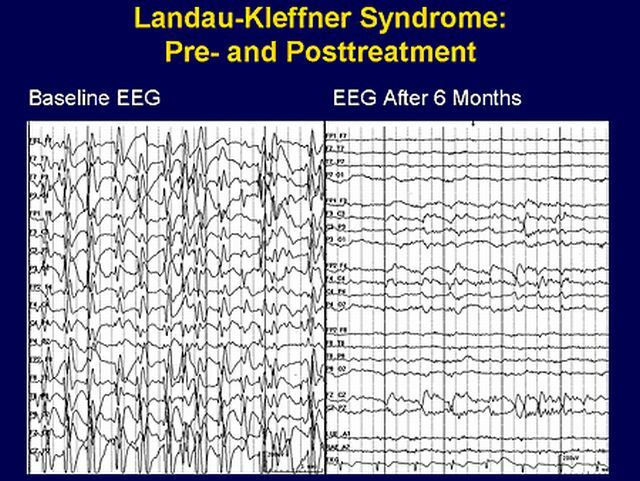 Dysgraphy is a complete or partial violation of written activity, which is connected with a deficit in the formation of those functions of the psyche that are responsible for the execution and control of the letter.
Dysgraphy is a complete or partial violation of written activity, which is connected with a deficit in the formation of those functions of the psyche that are responsible for the execution and control of the letter.
This pathology is characterized by constant and specific writing errors, which are not eliminated by themselves without a purposeful correction.
Practice shows that dysgraphy is very common among junior schoolchildren, this is because most children go to school with an inadequate phonetic-phonemic or general underdevelopment of speech. In the presence of such violations, the process of normal literacy is very complicated.
In terms of the severity of a written disorder, discography and agraphy are distinguished. In the first case, the letter is distorted, but it fulfills the function of communication, when writing takes place the inability to master the letter or the total loss of these abilities.
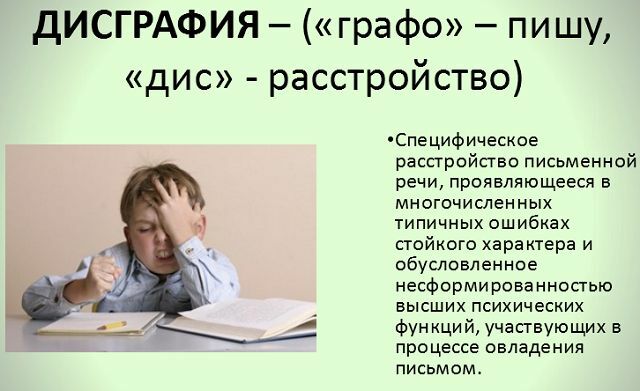
Contents
- What causes the development of a violation
- Deviation development mechanism
- Types of dysgraphy
- Typical manifestations of
- Common mistakes
- Associated deviations
- Professional diagnostics
- How is it possible to distinguish the disgraphy from illiteracy in practice?
- Correction of violation
- Exercises for elementary school children
- Chances for success - what are they?
What triggers the development of a violation
The following reasons can cause a violation:
- The developmental disadvantage of all categories of oral speech : sound, phonemic perception, lexico-grammatical aspect of speech, coherent speech.
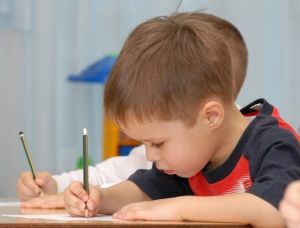
- Insufficient development or damage to the child's brain during pregnancy, at birth and during the post-birth period, and depletion of the nervous system .Such pathologies include: trauma at birth, asphyxia, meningitis, encephalitis, infectious and somatic diseases.
- Socio-psychological causes of .For example, if a child grows up in a family where they speak in several languages, in case of a lack of spoken communication, if the baby's speech is not given due attention by adults, the child's early preparation for training at a time when he is not ready for it.
- Predisposition or delay in mental development .
- Adult may occur as a result of head injuries or organic lesions of .
The deviation mechanism
The letter is a complex process that is performed with the participation of the speech-motor, the recursive, visual, motor analyzers, with the help of which the articulation is transferred to the phoneme, phoneme to grapheme, grapheme to kinem.
In order for a full-fledged training in writing skills, the formation of oral speech should be at the proper level.
The mechanism of deviation development is associated with the untimely formation of the leading cerebral hemisphere, responsible for speech abilities.
With normal indicators, these processes should be completed by the time the pre-school education begins. Provided untimely lateralization and the presence of hidden left-handedness, the process of control over the letter will be violated.
Also, with dysgraphy, all the cognitive spheres, visual analysis and synthesis, optical-spatial representations, phonemic processes, syllabic analysis and synthesis, the lexico-grammatical aspect of speech are not formed.
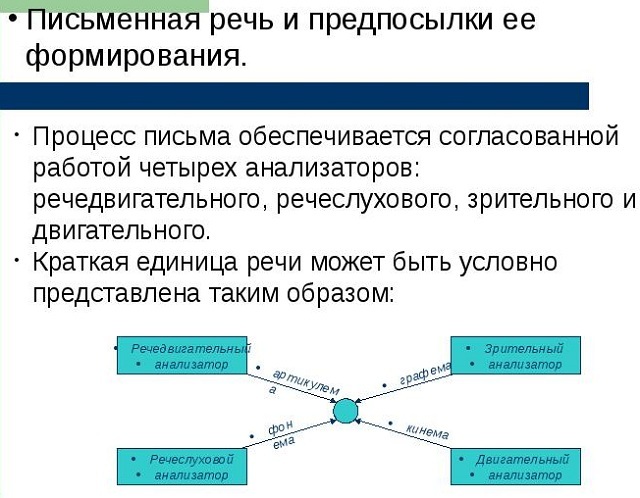
Types of
discography There are five types of dysgraphy:
- articulatory-acoustic , is associated with a violation of articulation, sound, phonemic perception;
- acoustic , caused by violation of phonemic recognition;
- dysgraphy on the background of the unformed language analysis and synthesis ;
- agrammatical - arises due to the incomplete development of lexico-grammatical speech and develops against the background of agrammatism;
- optical - is associated with the unformatted visual-spatial representations.
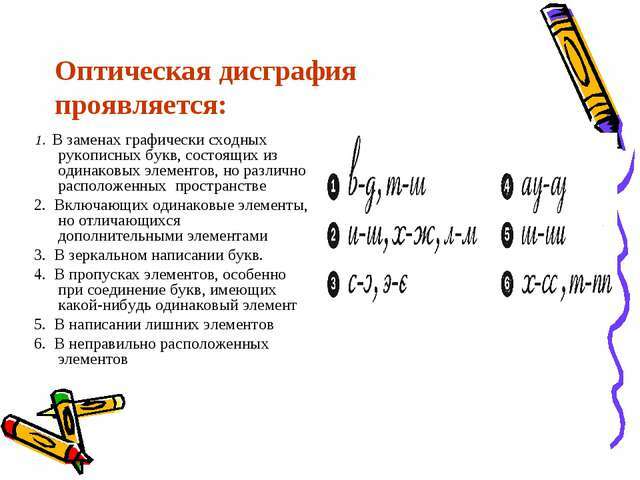
Typical manifestations of
Depending on the type of dysgraphy, the types of characteristic errors in writing and speech will differ:
- With articulate-acoustic , the allowed errors in writing are allowed due to incorrect pronunciation, ie the child writes as he says. In this case, the replacement and the transmission of symbols show the same errors in the conversation. This type of pathology occurs in children with phonetic-phonemic speech underdevelopment.
- With the acoustic form, the pronunciation is correct, but the phonemic perception is poorly developed. In this case, the errors have the form of substituting letters for similar ones.
- In the case of the , the disruption of language synthesis and analysis of the reveals the inability to separate words into syllables, and offerings for individual words. In this case, letters and syllables are dropped, duplicated or reversed, unnecessary symbols are added, words have no endings. Or, for example, a child writes words with conjunctions together, but separates consoles. This type of error is considered the most common.
- The agrammatical dysgraphy is characterized by inability to incline words by case, number, gender, violation of the combination of words in sentences, their inconsistency. This kind of pathology often accompanies the general speech underdevelopment.
- In the case of the optical , the violation forms are changed or mixed visually similar symbols. Literal optical dysgraphy is a violation of recognition and reproduction of individual letters. Verbal optical dysgraphy is a violation of the inscription of letters in a word.

The most common errors
Among the most common errors when writing, you can distinguish such: 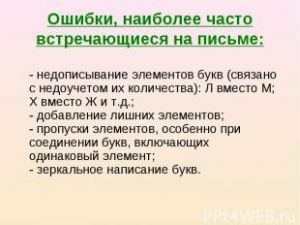
- non-writing of letter elements, for example P instead of F, W instead of B;
- adding unnecessary elements;
- skipping elements, particularly when combining letters that have a similar element;
- mirror writing of letters.
Associated deviations
Due to the close relationship of written and spoken speech, dysgraphia is often accompanied by dyslexia and alexia - violations of the reading process, verbal disturbances.
Often the dysgraphy is accompanied by signs of neurological disorders, poor performance, excessive activity, inability to concentrate attention, memory capacity decrease.
As for handwriting, it is often illegible, the letters are uneven, too large or vice versa, small. In order to perform the process of writing, the child makes great efforts, and still writes at a slow pace.
These children experience serious discomfort due to their mistakes and slowness. In addition, often, it causes discontent and irritation on the part of educators.
In communication, such a child can also experience some difficulties due to the inability to build long sentences correctly, so his speech can be rather brief and restrained.

Types of errors in dysgraphy
Professional diagnostics
The purpose of diagnosis is differentiation of dysgraphy from ordinary illiteracy, as well as revealing the form of this pathology.
The survey is carried out in stages and includes:
- analysis of written works;
- assessment of overall development and speech development in particular;
- analysis of the CNS, vision and hearing;
- study of the articulatory apparatus, speech motor skills.
The analysis of written speech is carried out with the help of such tasks:
- rewriting printed text and handwritten;
- dictation;
- description of the plot according to the figure;
- reading aloud.
After specific errors are identified, a protocol is drawn up and the expert concludes.
In this case, an important role will play early diagnosis, it will allow to begin correction in the initial stages of development of the deviation, if appropriate measures are not taken in childhood, symptoms of dysgraphia can be observed in adulthood.
How is it possible to distinguish between dysgraphy and illiteracy in practice?
In general, dysgraphy is found in a child only in the process of teaching a letter, that is, in an elementary school. By mistake, this pathology is sometimes mistaken for simple illiteracy, however, this is fundamentally wrong.
For example, a person who does not know the rules will write an "addendum", and such errors are not taken into account in dysgraphy, and the discrepancy is "bretloshenie", mistakes in this case resemble rough typos.
Correction of a violation of
 Children suffering from such a violation require qualified speech therapy, since it is simply impossible to eliminate this problem in normal school settings.
Children suffering from such a violation require qualified speech therapy, since it is simply impossible to eliminate this problem in normal school settings.
Correction work to eliminate dysgraphia will be developed based on the type of violation.
The objectives of this work are as follows:
- elimination of defects in sound and phonemic processes;
- increase the vocabulary;
- development of the grammatical side of speech;
- formation of coherent speech;
- development of analytical and synthetic ability;
- improved auditory and spatial perception;
- improvement of all cognitive spheres.
Skills obtained during correction are fixed through the execution of written assignments. In addition to a speech therapist, the child should be examined by a psychoneurologist for the presence of concomitant dysgraphia of disorders.
In the presence of such, treatment with medicines, physiotherapy procedures, manual therapy, therapeutic gymnastics will be prescribed.
Exercises for early school children
There are quite a few effective exercises for correcting the dysgraphy of junior schoolchildren who are selected by a specialist.
Here are some of them:
- Correction correction .Take a book that the child has never read before. The text should be printed in medium type. Give the task to emphasize in the text any one letter, for example, "A" or "O".You need to start with one letter. Exercise should be done no more than five minutes daily. In five days, you can proceed to complicate the task. For example, a child should emphasize one letter of "A", and then skip or traverse the next one. Then you need to invite him to mark pairs of letters that have some similarities( y / d, y / y, d / b, p / ton, p / p, m / l).
- We write aloud .The goal of the task is to say aloud everything that is written exactly in such a way as it is written and at the same time emphasize the weak parts. In this case, weak lobes are sounds that are not given attention during oral speech, for example, we say "loshka" or "a cup of malachum" melted on the steel. "It is these "mistakes" the child should emphasize. It is also very important to finish and clearly pronounce the endings of all words.
- Labyrinths of the .This game exercise contributes to the development of large motility, i.e. movements of the hands and forearm, as well as attention. The child should conduct a continuous line, it is important that he changes the position of the hand, and does not rotate the paper on which the picture is drawn.
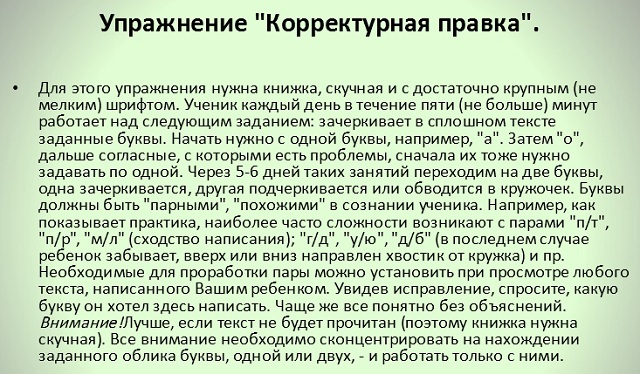

Chances for success - what are they?
Many parents are interested in the question, is it possible to get rid of this defect? Eliminate disgrafy is possible with the timely detection of the problem, as well as persistent systematic implementation of the classes.
Each child is individual, therefore, in order to cope with the violation, someone will need months, and someone for several years. Much will depend on the patience of parents and systematic studies with a speech therapist and at home.
An important point is the prevention of grammatical errors in the preschool age. This means that educators should pay attention to how the child utters sounds and builds sentences.
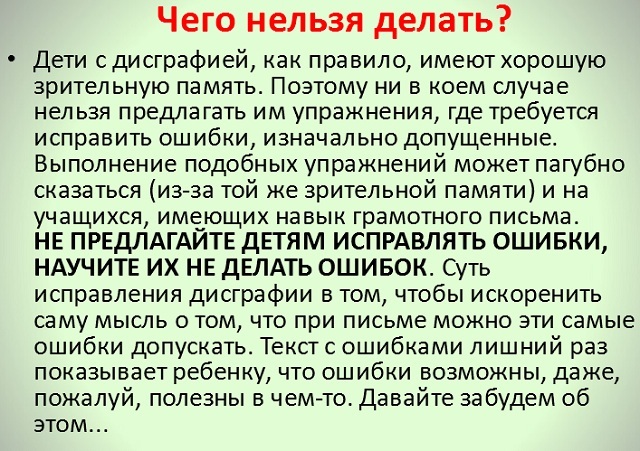
Also it is necessary to adhere to such rules:
- Do not teach the child to foreign languages at a time when the child is not yet ready for this psychologically .For example, many parents start learning a foreign language at the age of three.
- Parents should correctly and accurately speak at home .In no case can not be repeated for the child wrong words and phrases. This leads to the formation of incorrect speech.
- Choose pens and pencils so that they are equipped with a ribbed surface , because, as you know, massage finger pads to improve the work of the brain in the writing process.
- Provide the child with psychological support for , because kids with this problem often feel "not like everyone else".In no case should you criticize a child for mistakes. It is very important to apply the tactics of encouragement and praise for the successful completion of assignments.


